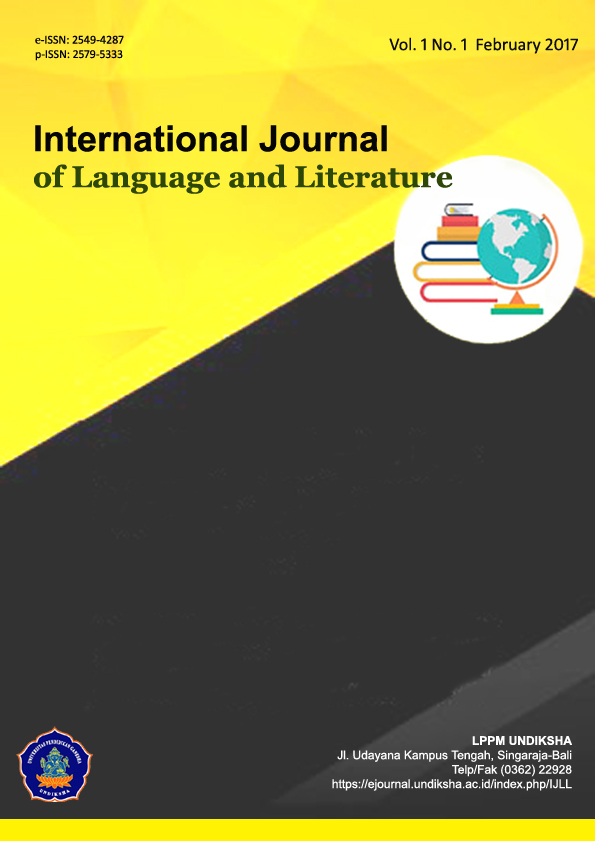Speech Acts In The Students’ English Textbook For Junior High School
DOI:
https://doi.org/10.23887/ijll.v6i2.27661Keywords:
speech acts, social function, linguistic features, language elementsAbstract
The current research objective was to analyse the ninth grade students’ textbook in the Junior High School publishes by the Indonesia Ministry of National Education based on the 2013 Curriculum. The research problems were focused on the speech acts’ social functions, linguistic features, and language elements. The research was designed in a qualitative approach. Data were analysed descriptively by classifying the speech acts’ social functions, linguistic features, and language elements. The research findings were, firstly, the speech acts’ social functions were stating, describing, explaining, ordering, asking, advising, praying, requesting, complimenting, thanking, boasting, congratulating, apologizing, welcoming, condoling, refusing, offering, guaranteeing, and promising acts. Secondly, the speech acts’ linguistic features designed were imperative, interrogative, and declarative sentences. Thirdly, the speech acts’ language elements used were simple present tense, present continuous tense, present perfect tense, simple past tense, past continuous tense, past perfect tense, and simple future tense.
References
Austin, J. (1962). How To Do Things With Words. London: Oxford University Press. Retrieved.from https://pure.mpg.de/rest/items/item_2271128/component/file_2271430/content.
Brown, H. D. (2001). Teaching by Principles: An Interactive Approach to Language Pedadogy . California: Longman Group.
Chang, C. B., Yao, Y., Haynes, E. F., & Rhodes, R. (2011). Production of Phonetics and Phonologicl contrast by Heritage Speakers of Mandarin. The Journal of The Acoustical Society of America, 3964-3980. DOI: https://doi.org/10.1121/1.3569736
Chomsky, N. (1975). Reflection on Language. University of California: Pantheon Books.
Cutting, J. (2002). Pragmatics and Discourse. London and New York: Routledge.
Harmer, J. (2001). The Practice of English Language Teaching (3rd Edition). New York: Longman Publising .
Huang, J. (2005). A Diary study of Difficulties and Constraints in EFL Learning. Elsevier, 609-621. DOI: https://doi.org/10.1016/j.system.2005.04.001
Hutchinson, T., & Gault, J. (2009). Project 5: Teacher's Book(3rd ed.). Oxford: Oxford University Press.
Kemendikbud. (2016). Peraturan Mentri Pendidikan dan Kebudayaan Nomor 21 Tahun 2016. Jakarta: Kemendibud. DOI: https://doi.org/10.24832/jpnk.v1i2.553
Lakoff, R. T. (1973). The Logic of Politness: Minding You P's and Q's . Chicago: Chicago Linguistic Society.
Leech, G. N. (1983). Principles of Pragmatics. University of California: Longman.
Lunenburg, F. C. (2010). Communication: The Process, Barriers, And Improving Effectiveness. Schooling.
Matthew B. Miles, A. M. (1994). Qualitative Data Analysis: An Expanded Sourcebook. Thousand Oaks: CA: Sage Publications.
Mey, J. L. (1993, July 30). How To Do Good Things With Words: A Social Pragmatics For Survival. Pragmatics, 4(2), 239-263. doi:10.1075/PRAG.4.2.04MEY. DOI: https://doi.org/10.1075/prag.4.2.04mey
Nunan, D. (1993). Introducing Discourse Analysis. London: Penguin.
Okeeffe, L. (2013). A Framework for Tetxbook Analysis. International Review of Contemporary Learning Research, 2(1), 1-13. DOI: https://doi.org/10.12785/irclr/020101
Parker, F. (1986). Linguistics for Non-Linguistics. London : Taylor and Francis, Ltd.
Saussure, F. d. (1915). Course in General Linguistics. Sweden: Open Court.
Searle, J. (1979). Expression and Meaning: Studies in the Theory of Speech Acts. London: Cmbridge University Press. DOI: https://doi.org/10.1017/CBO9780511609213
Searle, J. R. (1976, April). A Classification of Illocutionary Acts. Language in Society, 5(1), 1-23. Retrieved 2019, from http://www.jstor.org/stable/4166848 . DOI: https://doi.org/10.1017/S0047404500006837
Yule, G. (1996). Pragmatics. (H. G. Widdowson, Ed.) Oxford: Oxford University Press.
Downloads
Published
How to Cite
Issue
Section
License
Copyright (c) 2023 International Journal of Language and Literature

This work is licensed under a Creative Commons Attribution-ShareAlike 4.0 International License.
IJLL Journal provides immediate open access to its content on the principle that making research freely available to the public to supports a greater global exchange of knowledge.

This work is licensed under a Creative Commons Attribution-ShareAlike 4.0 International License







